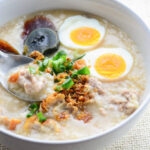Grits are a type of Southern cuisine made from ground corn that has been boiled in water or milk until it reaches a thick, porridge-like consistency. The dish is a staple in the cuisine of the Southern United States and is often served as a breakfast or brunch dish, even though it may also be used as a base for other meals or consumed as a side dish.
Grits are commonly prepared from hominy, a variety of corn that has had the hull and germ removed using an alkali solution. This process makes the corn easier to digest and also gives the grits a slightly different texture and flavor than regular cornmeal.
Grits can be prepared in many different ways, depending on the recipe and the cook’s preferences. They can be served plain or with a variety of toppings, such as butter, salt, cheese, bacon, shrimp, or gravy. Some popular variations include cheese grits, shrimp and grits, and red-eye gravy and grits.
| Ingredients: | |
| 1 | 1 cup of grits (either quick-cooking or regular) |
| 2 | 4 cups of water or milk |
| 3 | Salt and pepper to taste |
| 4 | Butter or cheese (optional) |
Step-by-step cooking instructions of Grits:
Step-1 In a medium-sized saucepan, bring the water or milk to a boil.
Step-2 Once the liquid has reached a rolling boil, gradually whisk in the grits. Make sure to constantly whisk to avoid lumps developing.
Step-3 Reduce the heat to low and cover the saucepan with a lid. Cook the grits for about 20-25 minutes, stirring occasionally to prevent sticking and lumps from forming. If you’re using quick-cooking grits, follow the package instructions for the cooking time.
Step-4 Once the grits are cooked, remove the saucepan from the heat and add salt and pepper to taste. You can also add butter or cheese at this point if desired, stirring until it’s melted and well combined.
Step-5 Serve the grits hot, either as a standalone dish or as a base for other dishes like shrimp and grits or red-eye gravy and grits.
Nutritional value of Grits:
The nutritional value of grits can vary slightly depending on the specific type of grits and the cooking method used. Here is a general overview of the approximate nutritional values for 1 cup (cooked) of plain grits made with water:
| 1 | Calories: 182 |
| 2 | Fat: 1 gram |
| 3 | Protein: 4 grams |
| 4 | Carbohydrates: 39 grams |
| 5 | Fiber: 1 gram |
| 6 | Sugar: 0 grams |
| 7 | Sodium: 6 milligrams |
| 8 | Calcium: 6% of the Daily Value (DV) |
| 9 | Iron: 10% of the DV |
It’s worth noting that the nutritional values can change depending on how the grits are prepared and what additional ingredients are added. For example, adding cheese, butter, or other toppings to the grits can significantly increase the fat and calorie content. Similarly, using milk instead of water to cook the grits can increase the protein and calcium content.
Overall, grits are a good source of complex carbohydrates and provide some protein and essential minerals like iron and calcium. However, they are relatively low in fiber and can be high in calories if prepared with added fats and toppings.
Background History of Grits:
The history of grits can be traced back to the indigenous peoples of the Southeastern United States, who were known to make a similar dish called hominy. Hominy is made by soaking dried corn kernels in an alkaline solution, which softens the hulls and makes the kernels easier to grind. This process, known as nixtamalization, was also used by ancient Mesoamerican cultures to prepare corn for tortillas and other dishes.
When European settlers arrived in the Southeastern United States, they adapted the indigenous technique for making hominy and began grinding the softened corn into a coarse meal known as grits. Grits quickly became a staple in the cuisine of the region, and by the 19th century, they were widely eaten throughout the Southern United States.
During the Civil War, grits became an important source of sustenance for soldiers on both sides of the conflict, as they were a cheap and abundant source of calories. After the war, grits continued to be a popular and affordable food, particularly among rural and working-class communities in the South.
Today, grits remain a beloved part of Southern cuisine and are enjoyed in a wide variety of dishes, from simple breakfast bowls to gourmet creations featuring shrimp, cheese, and other flavorful ingredients. They are also celebrated as a symbol of Southern culture and tradition, and are an important part of many regional festivals and celebrations.
| Advantages of Grits: | |
| 1 | Affordable: Grits are an affordable food option, making them accessible to a wide range of people. |
| 2 | Versatile: Grits can be used in a variety of dishes, including as a breakfast cereal, as a side dish, or as a base for savory dishes like shrimp and grits. |
| 3 | High in nutrients: Grits are a good source of iron, calcium, and B vitamins. |
| 4 | Easy to prepare: Grits are easy to prepare, typically requiring only water and salt to cook. |
| 5 | Gluten-free: Grits are naturally gluten-free, making them a good option for people with gluten intolerance or celiac disease. |
| Disadvantages of Grits: | |
| 1 | High in carobs: Grits are a high-carbohydrate food, which may not be ideal for people on low-carob or ketogenic diets. |
| 2 | Low in protein: Grits are relatively low in protein, which may not be ideal for people who are trying to increase their protein intake. |
| 3 | High in calories: Grits are relatively high in calories, particularly when prepared with added butter or cheese. |
| 4 | May contain additives: Some commercially produced grits may contain additives like preservatives or flavorings. |
| 5 | May be high in sodium: Grits may be high in sodium, particularly if salt is added during the cooking process. |
Compare with similar meal Grits:
| 1 | Polenta: Polenta is a cornmeal dish that is similar in texture to grits. It can be prepared in a variety of ways, including as a creamy side dish or as a firm base for savory dishes. |
| 2 | Cream of Wheat: Cream of Wheat is a hot cereal made from wheat semolina. It has a similar texture to grits and can be prepared with milk and sugar for a sweet breakfast dish. |
| 3 | Mashed Potatoes: Mashed potatoes have a creamy, smooth texture that is similar to grits. They can be served as a side dish or used as a base for savory dishes. |
| 4 | Farina: Farina is a hot cereal made from wheat. It has a similar texture to Cream of Wheat and can be prepared in a similar way. |
| 5 | Couscous: Couscous is a North African dish made from tiny balls of semolina. It has a similar texture to grits and can be used as a base for savory dishes. |
These dishes all have a similar texture to grits and can be prepared in a variety of ways to suit different tastes and dietary needs.
Mostly questions asked about Grits:
Q: What are grits?
A: Grits are a traditional Southern American food prepared from crushed grain that has been simmered in milk or water to resemble thick porridge. They are frequently served as a breakfast dish, but they can also be used as a base for savory recipes or as a side dish.
Q: Are grits healthy?
A: Grits can be a healthy food choice as they are a good source of iron, calcium, and B vitamins. However, they can also be high in calories and carbohydrates, particularly when prepared with added butter or cheese. It’s important to consider portion size and the way grits are prepared to ensure they fit into a balanced diet.
Q: How are grits typically served?
A: Grits are often served as a breakfast dish, topped with butter, salt, and pepper. They can also be served as a side dish, often accompanied by seafood dishes, or used as a base for savory dishes like shrimp and grits.
Q: Are grits gluten-free?
A: Yes, grits are naturally gluten-free as they are made from corn.
Q: How do you prepare grits?
A: To prepare grits, you typically boil them in water or milk, stirring occasionally until they thicken to a porridge-like consistency. The specific preparation instructions can vary depending on the type of grits and the desired texture.
Q: What are the different types of grits?
A: The two main types of grits are instant grits and traditional grits. Instant grits are pre-cooked and can be prepared quickly, while traditional grits require longer cooking times and can have a coarser texture. Stone-ground grits are a type of traditional grits that are made by grinding whole corn kernels between two large stones, resulting in a coarser texture and richer flavor.
Q: Why are grits called grits?
A: Grits are either white or yellow maize that has been dried, ground, and then hulled. The word “grist,” which was used by early settlers in the South to refer to any ground cereal grain, is where the word “grits” originates. The “grist mills” were the mills used to produce grist.”
Q: What is the secret to cooking grits?
A: The secret to making authentic grits is to cook them over a low heat so that their starches slowly dissolve, giving them a rich, velvety feel. Lump-free cooking is achieved by repeatedly whisking after the first few minutes of cooking and continuously whisking thereafter.
Q: Are grits better with milk or water?
A: Grits come in both yellow and white varieties, and they can both take on most flavors when combined with them, albeit milk, rather than water, is always the preferred method for making them. Astonishingly, there is a change in both flavor and consistency.
Q: Which country invented grits?
A: The Native American Muskogee tribes of the southeastern states, such as Tennessee, Alabama, Georgia, and Florida, are where grits first appeared in the 16th century. These tribes are attributed with giving colonists dried grain that was ground into a coarse, gritty texture.







